Development of High-Silica Adakitic Intrusions in the Northern Appalachians of New Brunswick (Canada), and Their Correlation with Slab Break-Off: Insights into the Formation of Fertile Cu-Au-Mo Porphyry Systems
Abstract
:1. Introduction
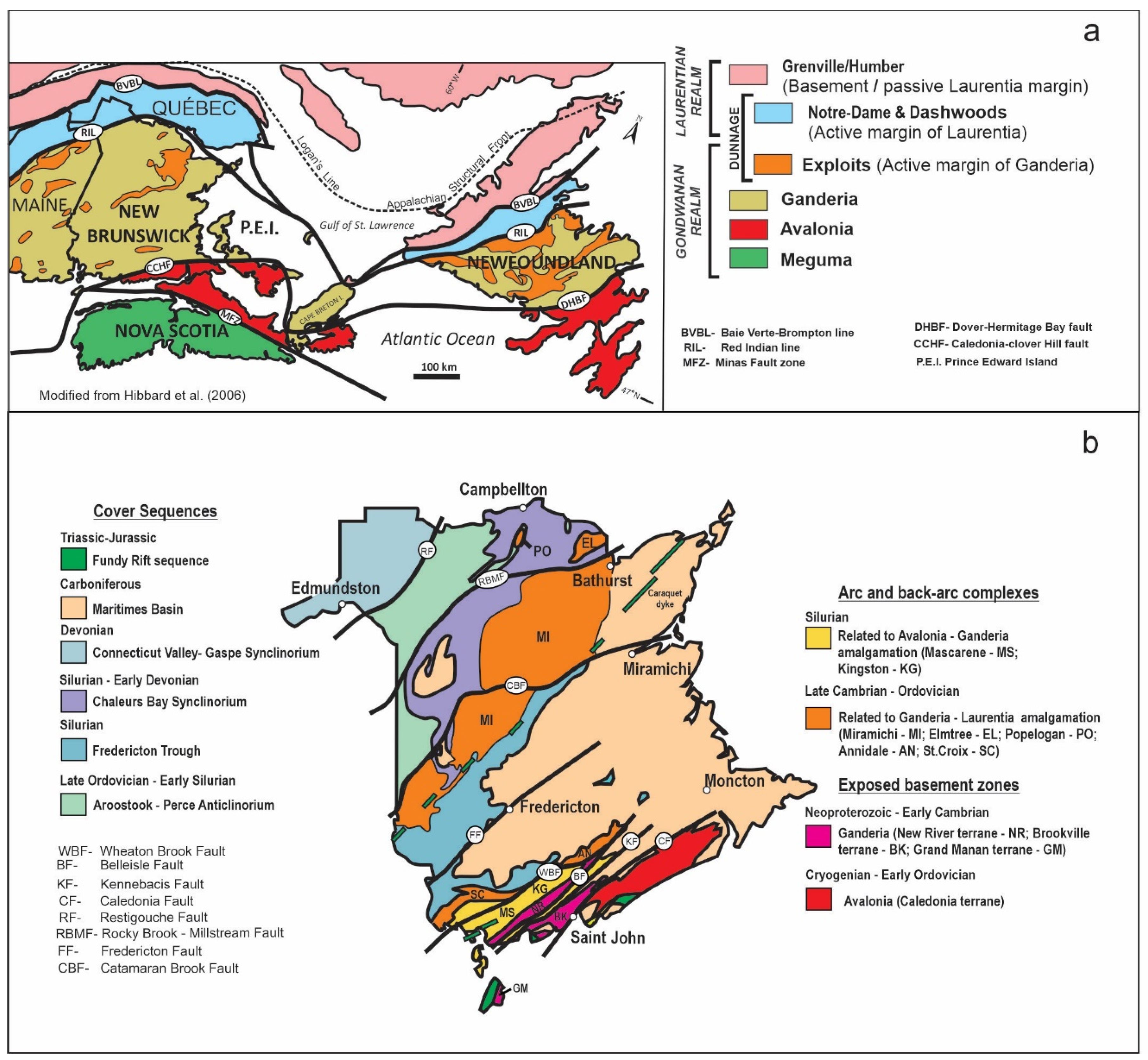

2. Methods
3. Results
Geochemistry
4. Discussion
4.1. Magmatic Sources of New Brunswick Adakites
4.2. Tectonic Setting
5. Conclusions
Supplementary Materials
Author Contributions
Funding
Data Availability Statement
Acknowledgments
Conflicts of Interest
References
- Williams, H.; Colman-Sadd, S.P.; Swinden, H.S. Tectono-stratigraphic subdivisions of central Newfoundland. Geol. Surv. Can. Pap. 1988, 88-1B, 91–98. [Google Scholar]
- Yousefi, F.; Lentz, D.R.; Thorne, K.G. Mineral Chemistry of the Eagle Lake Granite Porphyry, Southwestern New Brunswick, Canada: Implications for Cu-Mo-Au Mineralization. Can. J. Mineral. Petrol. 2023, 61, 445–465. [Google Scholar] [CrossRef]
- Castillo, P.R. An overview of adakite petrogenesis. Chin. Sci. Bull. 2006, 51, 257–268. [Google Scholar] [CrossRef]
- Kay, R.W. Aleutian magnesian andesites: Melts from subducted Pacific Ocean crust. J. Volcanol. Geotherm. Res. 1978, 4, 117–132. [Google Scholar] [CrossRef]
- Lentz, D.R.; Yousefi, F. Reconciling Adakite Geochemical Systematics: A review. In Abstracts 2022: Atlantic Geoscience Society Colloquium 2022; Fredericton, NB, Canada, 2022; p. 1. [Google Scholar]
- Condie, K.C. TTGs and adakites: Are they both slab melts? Lithos 2005, 80, 33–44. [Google Scholar] [CrossRef]
- Yousefi, F.; Lentz, D.R. Formation of high-silica adakites and their relationship with slab break-off: Implications for generating fertile Cu-Au-Mo porphyry systems. Geosci. Front. 2024, 1–20. [Google Scholar]
- Bustard, A.L.; Lentz, D.R.; Walker, J.A.; McFarlane, C.R.M. Two episodes of crustal melting recorded by dykes along the gold-bearing Melanson Brook Fault, northern New Brunswick, Appalachians. Can. J. Earth Sci. 2024, 1–32. [Google Scholar] [CrossRef]
- Pilote, J.L.; Barr, S.M.; Wilson, R.A.; McClenaghan, S.; Kamo, S.; McNicoll, V.J.; Bevier, M.L. Precise age and petrology of Silurian-Devonian plutons in the Benjamin River–Charlo area, northern New Brunswick. Atl. Geol. 2021, 48, 97–123. [Google Scholar] [CrossRef]
- Walker, J.A.; Gower, S.J.; McCutcheon, S.R. Antinouri-Nicholas project, northern New Brunswick, in S.A. Abbott ed., Project Summaries for 1991. In Sixteenth Annual Review of Activities; New Brunswick Department of Natural Resources and Energy, Mineral Resources, Information Circular: Fredericton, NB, Canada, 1991; Volume 91-2, pp. 87–100. [Google Scholar]
- Wilson, R.A. The Middle Paleozoic Rocks of Northern and Western New Brunswick, Canada; New Brunswick Department of Energy and Resource Development; Geological Surveys Branch: Fredericton, NB, Canada, 2017; Memoir 4; 319p. [Google Scholar]
- MacLellan, H.E. Geology and Geochemistry of Middle Devonian Burnthill Brook Granites and Related Tin-Tungsten Deposits, York and Northumberland Counties, New Brunswick; Minerals and Energy Division Department of Natural Resources and Energy: Fredericton, NB, Canada, 1990; 104p. [Google Scholar]
- Heidarian, H. Examination of Mesothermal to Epithermal Orogenic-to Intrusion-Related Sb-Bearing Gold System in a Southern New Brunswick Segment of the Northern Appalachians. Ph.D. Thesis, University of New Brunswick, Fredericton, NB, Canada, 2022. [Google Scholar]
- Whalen, J.B.; Jenner, G.A.; Longstaffe, F.J.; Hegner, E. Nature and evolution of the eastern margin of lapetus: Geochemical and isotopic constraints from Siluro-Devonian granitoid plutons in the New Brunswick Appalachians. Can. J. Earth Sci. 1996, 33, 140–155. [Google Scholar] [CrossRef]
- Yousefi, F.; Lentz, D.R.; Thorne, K.G.; McFarlane, C.R.; Cousens, B. Petrogenesis of Eagle Lake Granite and Its Associated Cu–Mo–Au Mineralization, Southwestern New Brunswick, Canada. Minerals 2023, 13, 594. [Google Scholar] [CrossRef]
- Yousefi, F.; White, T.; Lentz, D.R.; McFarlane, C.R.; Thorne, K.G. Middle Devonian Evandale porphyry Cu-Mo (Au) deposit, southwestern New Brunswick, Canada: Analysis of petrogenesis to potential as a source for distal intrusion-related epithermal gold mineralization. Ore Geol. Rev. 2023, 162, 105716. [Google Scholar] [CrossRef]
- Shinkle, D.A. The Long Lake Uranium Prospect: Intragranitic Vein-Type Uranium Mineralization in North-Central New Brunswick, Canada. Master’s Thesis, The University of New Brunswick, Fredericton, NB, Canada, 2011; 297p. [Google Scholar]
- Azadbakht, Z. Using Biotite and Apatite Compositions to Differentiate Barren and Mineralized Silurian-Devonian Granitoid Plutons in New Brunswick, Canada. Ph.D. Thesis, University of New Brunswick, Fredericton, NB, Canada, 2019. [Google Scholar]
- Mohammadi, N.; Lentz, D.R.; Cousens, B.; Walker, J.A.; McFarlane, C.R.M.; Rogers, N. Lithogeochemical and isotopic characterization of Devonian molybdenite mineralization in the Pabineau Falls Granite, northeastern New Brunswick, Canada. J. Geochem. Explor. 2022, 234, 106925. [Google Scholar] [CrossRef]
- Massawe, R.J.; Lentz, D.R. Evaluation of crystallization and emplacement conditions of the McKenzie Gulch porphyry dykes using chemistry of rock-forming minerals: Implications for mineralization potential. Ore Geol. Rev. 2020, 116, 103256. [Google Scholar] [CrossRef]
- Stephenson, E.M.; Meinert, L.D.; Mortensen, J.K.; Hussey, J. Age and skarn alteration of the Porphyry Mountain Cu-Mo deposit, Mines Gaspé, Québec. Geol. Soc. Am. Annu. Meet. Program Abstr. 1998, 30, 372. [Google Scholar]
- Marcelissen, M.; Hollings, P.; Cooke, D.R.; Baker, M.J.; Belousov, I.; Orovan, E.; Friedman, R. Geochronology of the Mine Gaspé Porphyry deposit, Québec, Canada. Can J. Earth Sci. 2024, 61, 876–893. [Google Scholar] [CrossRef]
- Loferski, P.J.; Ayuso, R.A. Petrography and mineral chemistry of the composite Deboullie pluton, northern Maine, USA: Implications for the genesis of Cu-Mo mineralization. Chem. Geol. 1995, 123, 89–105. [Google Scholar] [CrossRef]
- Ishihara, S.; Imai, A. Oxidized granitic magmas and porphyry copper mineralization. In Modelling of Magmatic and Allied Processes; Kumar, S., Singh, R.N., Eds.; Society of Earth Scientists Series; Springer International Publishing: Cham, Switzerland, 2014; pp. 209–223. [Google Scholar]
- Sun, W.; Arculus, R.J.; Kamenetsky, V.S.; Binns, R.A. Release of gold-bearing fluids in convergent margin magmas prompted by magnetite crystallization. Nature 2004, 431, 975–978. [Google Scholar] [CrossRef]
- Ishihara, S. Granitoid series and mineralization in the Circum-Pacific Phanerozoic granitic belts. Resour. Geol. 1998, 48, 219–224. [Google Scholar] [CrossRef]
- Hibbard, J.; Karabinos, P. Disparate paths in the geologic evolution of the northern and southern Appalachians: A case for inherited contrasting crustal/lithospheric substrates. Geosci. Can. 2013, 40, 303–317. [Google Scholar] [CrossRef]
- Fyffe, L.R.; Thorne, K.G.; Dunning, G.R.; Martin, D.A. U–Pb geochronology of the Sisson Brook Granite Porphyry, York County, west-central New Brunswick. In Geological Investigations in New Brunswick for 2007; Martin, G.L., Ed.; Mineral Resource Report; New Brunswick Department of Natural Resources; Minerals, Policy and Planning Division: Fredericton, NB, Canada, 2008; Volume 1, pp. 35–54. [Google Scholar]
- Whalen, J.B. Geology, Petrography and Geochemistry of Appalachian Granites in New Brunswick and Gaspésie, Québec; Energy, Mines and Resources Canada, Geological Survey of Canada: Ottawa, ON, Canada, 1993; 124p. [Google Scholar]
- Norrish, K.; Hutton, J.T. An accurate X-ray spectrographic method for the analysis of a wide range of geological samples. Geochim. Cosmochim Acta 1969, 33, 431–453. [Google Scholar] [CrossRef]
- Hoffman, E.L. Instrumental neutron activation in geoanalysis. J. Geochem. Explor. 1992, 44, 297–319. [Google Scholar] [CrossRef]
- Cox, K.G.; Bell, J.D.; Pankhurst, R.J. The Interpretation of Igneous Rocks; George Allen and Unwin: London, UK, 1979; 450p. [Google Scholar]
- Peccerillo, A.; Taylor, S.R. Geochemistry of Eocene calc-alkaline volcanic rocks from the Kastamonu area, northern Turkey. Contrib. Mineral. Petrol. 1976, 58, 63–81. [Google Scholar] [CrossRef]
- Shand, S.J. The Eruptive Rocks, 2nd ed.; John Wiley: New York, NY, USA, 1943; 444p. [Google Scholar]
- Chappell, B.W.; White, A.J.R. Two contrasting granite types. Pac. Geol. 1974, 8, 173–174. [Google Scholar]
- Frost, B.R.; Barnes, C.G.; Collins, W.J.; Arculus, R.J.; Ellis, D.J.; Frost, C.D. A geochemical classification for granitic rocks. J. Petrol. 2001, 42, 2033–2048. [Google Scholar] [CrossRef]
- Martin, H.; Smithies, R.H.; Rapp, R.; Moyen, J.F.; Champion, D. An overview of adakite, tonalite–trondhjemite–granodiorite (TTG), and sanukitoid: Relationships and some implications for crustal evolution. Lithos 2005, 79, 1–24. [Google Scholar] [CrossRef]
- Sun, S.S.; McDonough, W.F. Chemical and isotopic systematics of oceanic basalts: Implications for mantle composition and processes. Geol. Soc. Lond. Spec. Publ. 1989, 42, 313–345. [Google Scholar] [CrossRef]
- Yousefi, F.; Lentz, D.R. Analysis of the Relationship between High-Silica Adakites and Slab Break-Off: Implications for Forming Associated Porphyry Deposits Worldwide; Mediterranean Geoscience Union (MedGU): Istanbul, Turkey, 2023; p. 1. [Google Scholar]
- Whalen, J.B.; Currie, K.L.; Chappell, B.W. A-type granites: Geochemical characteristics, discrimination and petrogenesis. Contrib. Mineral. Petrol. 1987, 95, 407–419. [Google Scholar] [CrossRef]
- Castillo, P.R. Adakite petrogenesis. Lithos 2012, 134, 304–316. [Google Scholar] [CrossRef]
- Falloon, T.J.; Danyushevsky, L.V.; Crawford, A.J.; Meffre, S.; Woodhead, J.D.; Bloomer, S.H. Boninites and adakites from the northern termination of the Tonga Trench: Implications for adakite petrogenesis. J. Petrol. 2008, 49, 697–715. [Google Scholar] [CrossRef]
- Zhang, L.; Li, S.; Zhao, Q. A review of research on adakites. Int. Geol. Rev. 2019, 63, 47–64. [Google Scholar] [CrossRef]
- Rapp, R.P.; Shimizu, N.; Norman, M.D.; Applegate, G.S. Reaction between slab-derived melts and peridotite in the mantle wedge: Experimental constraints at 3.8 GPa. Chem. Geol. 1999, 160, 335–356. [Google Scholar] [CrossRef]
- Topuz, G.; Okay, A.I.; Altherr, R.; Schwarz, W.H.; Siebel, W.; Zack, T.; Satır, M.; Şen, C. Post-collisional adakite-like magmatism in the Ağvanis Massif and implications for the evolution of the Eocene magmatism in the Eastern Pontides (NE Turkey). Lithos 2011, 125, 131–150. [Google Scholar] [CrossRef]
- Chiaradia, M.; Müntener, O.; Beate, B.; Fontignie, D. Adakite-like volcanism of Ecuador: Lower crust magmatic evolution and recycling. Contrib. Mineral. Petrol. 2009, 158, 563–588. [Google Scholar] [CrossRef]
- Archibald, D.B.; Murphy, J.B. A slab failure origin for the Donegal composite batholith, Ireland as indicated by trace-element geochemistry. Geol. Soc. Lond. Spec. Publ. 2021, 503, 347–370. [Google Scholar] [CrossRef]
- Whalen, J.B.; Hildebrand, R.S. Trace element discrimination of arc, slab failure, and A-type granitic rocks. Lithos 2019, 348, 105179. [Google Scholar] [CrossRef]
- Yousefi, F.; Lentz, D.R.; Walker, J.A.; Thorne, K.G. Is the genesis of porphyry Cu-related adakitic rocks in New Brunswick, a result of slab failure? In Abstracts 2024: Atlantic Geoscience Society Colloquium; Moncton, NB, Canada, 2024; p. 1. [Google Scholar]
- Hildebrand, R.S.; Whalen, J.B.; Bowring, S.A. Resolving the crustal composition paradox by 3.8 billion years of slab failure magmatism and collisional recycling of continental crust. Tectonophysics 2018, 734, 69–88. [Google Scholar] [CrossRef]
- Hildebrand, R.S.; Whalen, J.B. Arc and slab-failure magmatism in Cordilleran Batholiths I: The Cretaceous Coastal Batholith of Peru and its role in South American Orogenesis and Hemispheric Subduction Flip. Geosci. Can. 2014, 41, 255–282. [Google Scholar] [CrossRef]
- Green, T.H.; Pearson, N.J. An experimental study of Nb and Ta partitioning between Ti-rich minerals and silicate liquids at high pressure and temperature. Geochim. Cosmochim. Acta 1987, 51, 55–62. [Google Scholar] [CrossRef]
- Pearce, J.A. Immobile element fingerprinting of ophiolites. Elements 2014, 10, 101–108. [Google Scholar] [CrossRef]
- Eyuboglu, Y.; Chung, S.L.; Santosh, M.; Dudas, F.O.; Akaryalı, E. Transition from shoshonitic to adakitic magmatism in the Eastern Pontides, NE Turkey: Implications for slab window melting. Gondwana Res. 2011, 19, 413–429. [Google Scholar] [CrossRef]
- Batchelor, R.A.; Bowden, P. Petrogenetic interpretation of granitoid rock series using multicationic parameters. Chem. Geol. 1985, 48, 43–55. [Google Scholar] [CrossRef]
- Fossen, H.; Tikoff, B. Extended models of transpression and transtension, and application to tectonic settings. Geol. Soc. Lond. Spec. Publ. 1998, 135, 15–33. [Google Scholar] [CrossRef]
- Piette-Lauzière, N.; Larson, K.P.; Kellett, D.A.; Harris, L.; Cleven, N.; Rogers, N. Late Devonian syntaxis in the Northern Appalachian Orogen. Geol. Soc. Lond. Spec. Publ. 2024, 542, 259–286. [Google Scholar] [CrossRef]
- Strong, D.F. A model for granophile mineral deposits. Geosci. Can. 1981, 8, 155–161. [Google Scholar]
- Preston, L.A.; Creager, K.C.; Crosson, R.S.; Brocher, T.M.; Trehu, A.M. Intraslab earthquakes: Dehydration of the Cascadia slab. Science 2003, 302, 1197–1200. [Google Scholar] [CrossRef]
- Spandler, C.; Pirard, C. Element recycling from subducting slabs to arc crust: A review. Lithos 2013, 170, 208–223. [Google Scholar] [CrossRef]
- Sillitoe, R.H. Gold deposits in western Pacific island arcs; the magmatic connection. Econ. Geol. Monogr. 1989, 6, 274–291. [Google Scholar]
- Richards, J.P. Postsubduction porphyry Cu-Au and epithermal Au deposits: Products of remelting of subduction-modified lithosphere. Geology 2009, 37, 247–250. [Google Scholar] [CrossRef]
- Sillitoe, R.H. Porphyry-copper systems. Econ. Geol. 2010, 105, 3–41. [Google Scholar] [CrossRef]
- Gibert, F.; Pascal, M.L.; Pichavant, M. Gold solubility and speciation in hydrothermal solutions: Experimental study of the stability of hydrosulphide complex of gold (AuHS) at 350 to 450 C and 500 bars. Geochim. Cosmochim. Acta 1998, 62, 2931–2947. [Google Scholar] [CrossRef]
- Gammons, C.H.; Williams-Jones, A.E. Chemical mobility of gold in the porphyry-epithermal environment. Econ. Geol. 1997, 92, 45–59. [Google Scholar] [CrossRef]
- van Staal, C.R.; Barr, S.M.; Percival, J.A.; Cook, F.A.; Clowes, R.M. Lithospheric architecture and tectonic evolution of the Canadian Appalachians and associated Atlantic margin. Geol. Assoc. Can.-Spec. Pap. 2012, 49, 41–95. [Google Scholar]
- Murphy, J.; van Staal, C.R.; Duncan Keppie, J. Middle to late Paleozoic Acadian orogeny in the northern Appalachians: A Laramide-style plume-modified orogeny? Geology 1999, 27, 653–656. [Google Scholar] [CrossRef]
- Wilson, R.A.; van Staal, C.R.; Kamo, S. Lower Silurian subduction-related volcanic rocks in the Chaleurs Group, northern New Brunswick, CanadaGeological Survey of Canada, Contribution No. 2008-0166. Contribution to Natural Resources Canada’s Targeted Geoscience Initiative 3 (2005–2010). Can. J. Earth Sci. 2008, 45, 981–998. [Google Scholar] [CrossRef]
- Whalen, J.B.; McNicoll, V.J.; van Staal, C.R.; Lissenberg, C.J.; Longstaffe, F.J.; Jenner, G.A.; van Breeman, O. Spatial, temporal and geochemical characteristics of Silurian collision-zone magmatism, Newfoundland Appalachians: An example of a rapidly evolving magmatic system related to slab break-off. Lithos 2006, 89, 377–404. [Google Scholar] [CrossRef]
- Karsli, O.; Şengün, F.; Santos, J.F.; Uysal, İ.; Dokuz, A.; Aydin, F.; Kandemir, R. Late Jurassic Paleotethyan oceanic slab break-off revealed by Sr-Nd-Hf isotopes of Na-rich adakitic granites from northwestern Turkey. Gondwana Res. 2022, 103, 205–220. [Google Scholar] [CrossRef]
- Whalen, J.B.; Fyffe, L.R.; Longstaffe, F.J.; Jenner, G.A. The position and nature of the Gander–Avalon boundary, southern New Brunswick, based on geochemical and isotopic data from granitoid rocks. Can. J. Earth Sci. 1996, 33, 129–139. [Google Scholar] [CrossRef]
- Ayuso, R.A.; Bevier, M.L. Regional differences in Pb isotopic compositions of feldspars in plutonic rocks of the northern Appalachian Mountains, USA, and Canada: A geochemical method of terrane correlation. Tectonics 1991, 10, 191–212. [Google Scholar] [CrossRef]

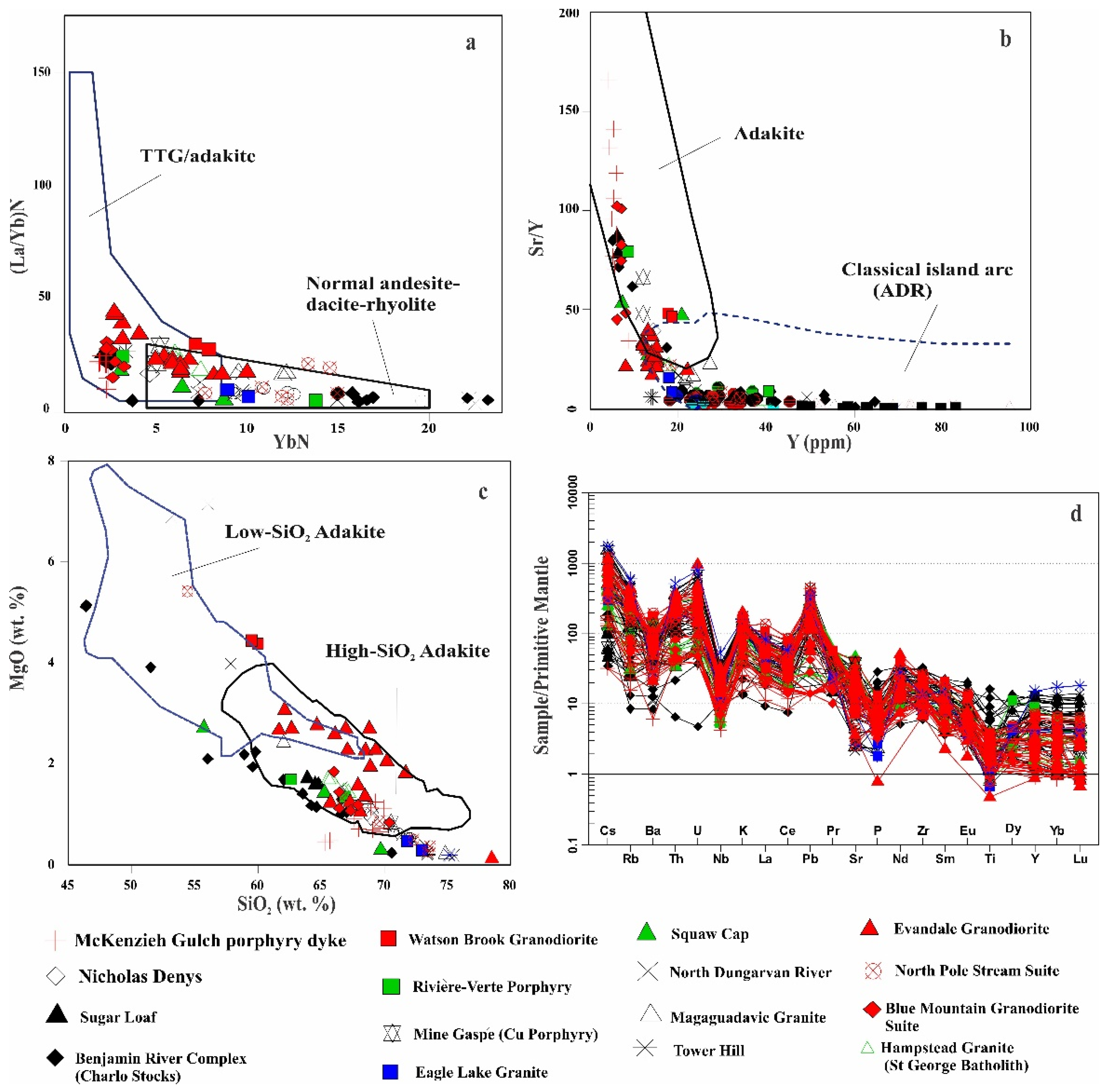
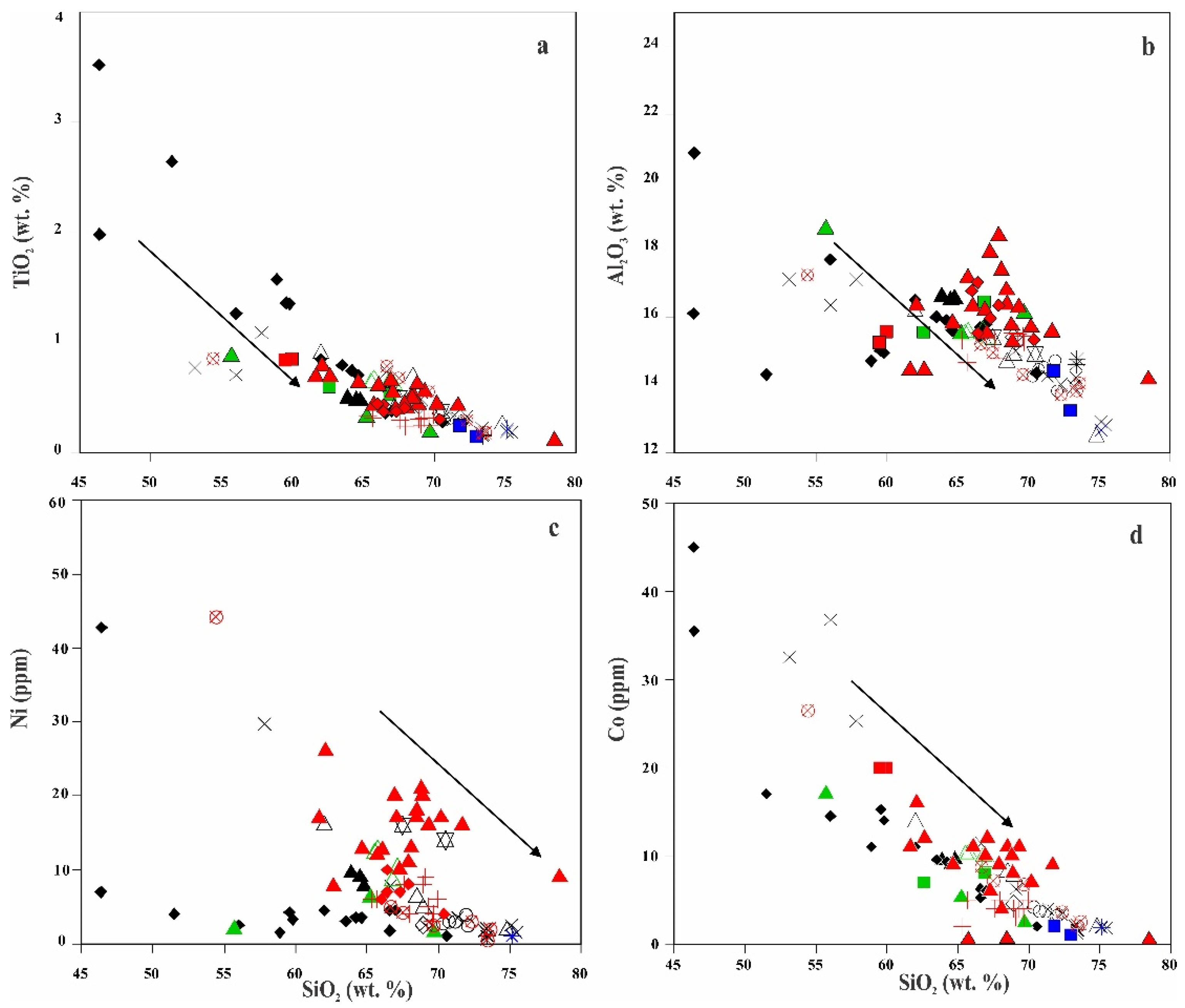
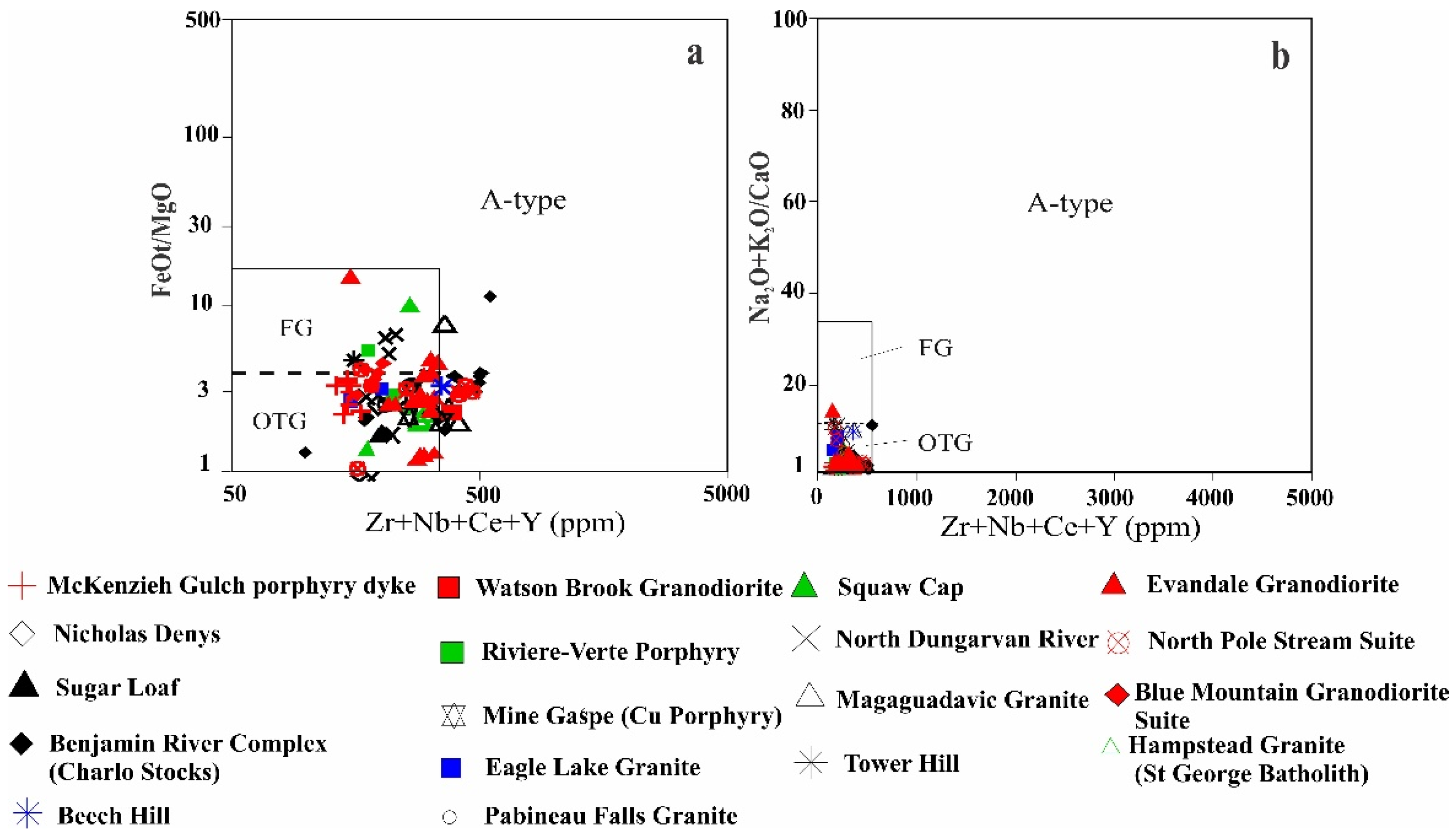
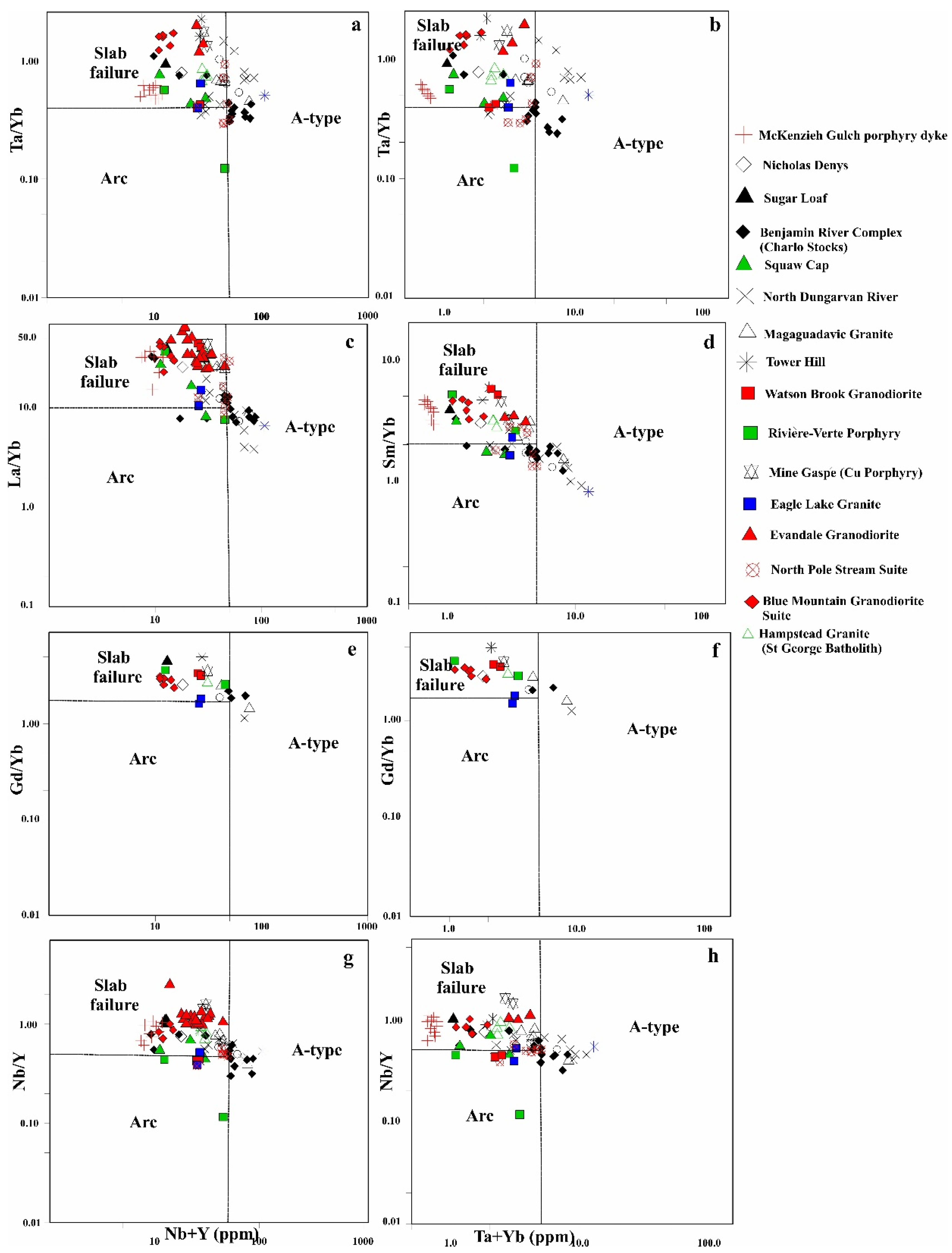



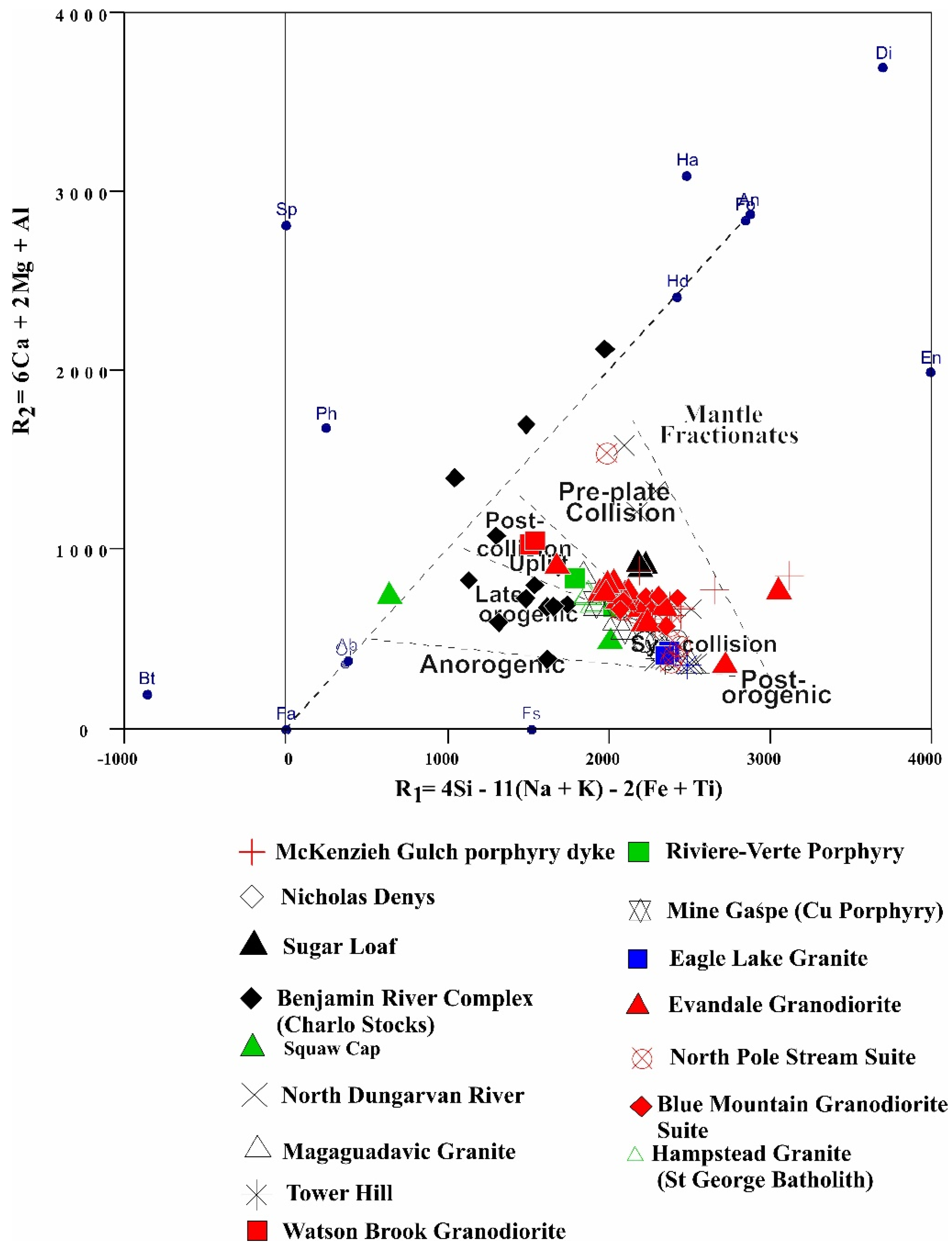
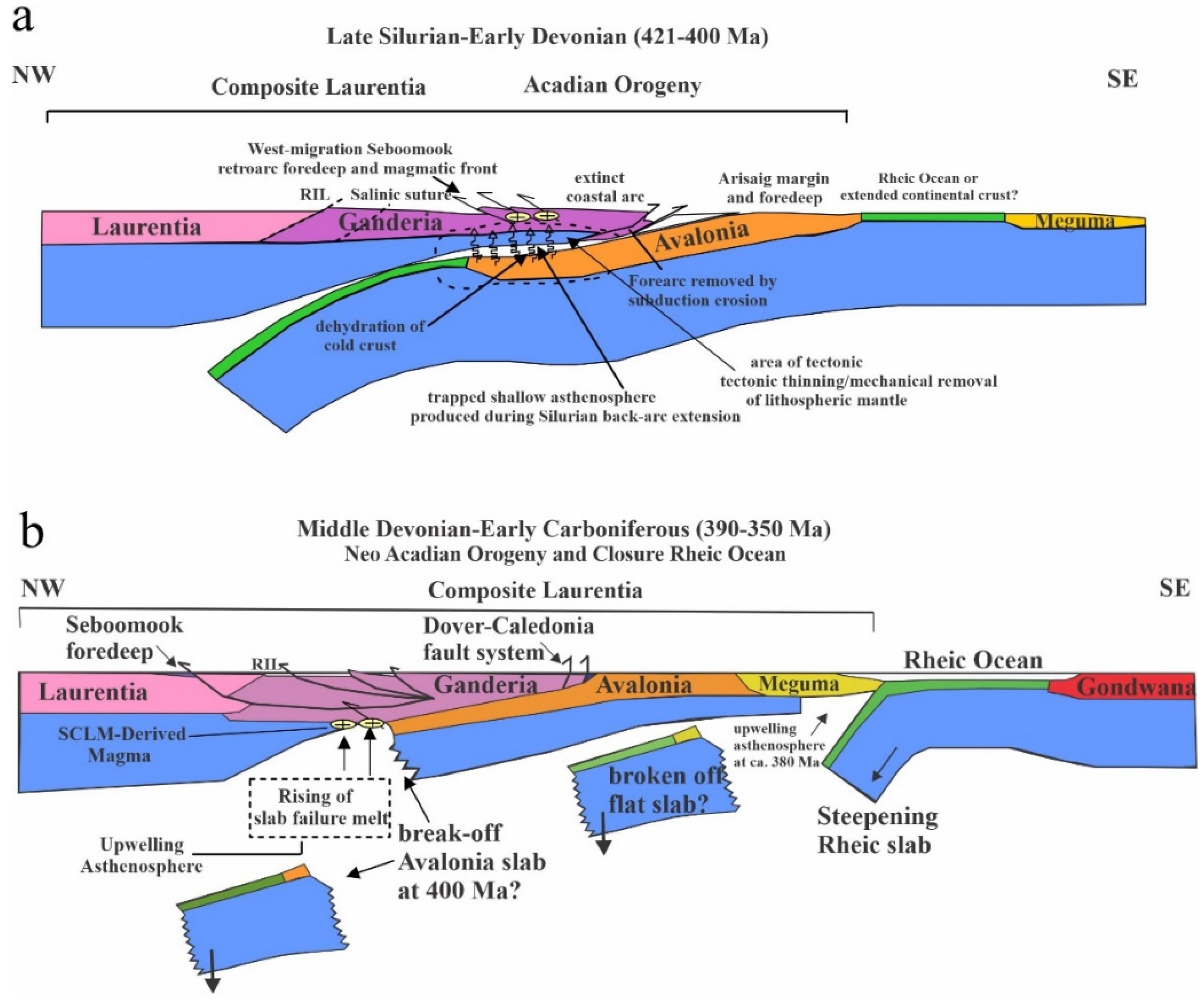
Disclaimer/Publisher’s Note: The statements, opinions and data contained in all publications are solely those of the individual author(s) and contributor(s) and not of MDPI and/or the editor(s). MDPI and/or the editor(s) disclaim responsibility for any injury to people or property resulting from any ideas, methods, instructions or products referred to in the content. |
© 2024 by the authors. Licensee MDPI, Basel, Switzerland. This article is an open access article distributed under the terms and conditions of the Creative Commons Attribution (CC BY) license (https://creativecommons.org/licenses/by/4.0/).
Share and Cite
Yousefi, F.; Lentz, D.R.; Walker, J.A.; Thorne, K.G. Development of High-Silica Adakitic Intrusions in the Northern Appalachians of New Brunswick (Canada), and Their Correlation with Slab Break-Off: Insights into the Formation of Fertile Cu-Au-Mo Porphyry Systems. Geosciences 2024, 14, 241. https://doi.org/10.3390/geosciences14090241
Yousefi F, Lentz DR, Walker JA, Thorne KG. Development of High-Silica Adakitic Intrusions in the Northern Appalachians of New Brunswick (Canada), and Their Correlation with Slab Break-Off: Insights into the Formation of Fertile Cu-Au-Mo Porphyry Systems. Geosciences. 2024; 14(9):241. https://doi.org/10.3390/geosciences14090241
Chicago/Turabian StyleYousefi, Fazilat, David R. Lentz, James A. Walker, and Kathleen G. Thorne. 2024. "Development of High-Silica Adakitic Intrusions in the Northern Appalachians of New Brunswick (Canada), and Their Correlation with Slab Break-Off: Insights into the Formation of Fertile Cu-Au-Mo Porphyry Systems" Geosciences 14, no. 9: 241. https://doi.org/10.3390/geosciences14090241
APA StyleYousefi, F., Lentz, D. R., Walker, J. A., & Thorne, K. G. (2024). Development of High-Silica Adakitic Intrusions in the Northern Appalachians of New Brunswick (Canada), and Their Correlation with Slab Break-Off: Insights into the Formation of Fertile Cu-Au-Mo Porphyry Systems. Geosciences, 14(9), 241. https://doi.org/10.3390/geosciences14090241






